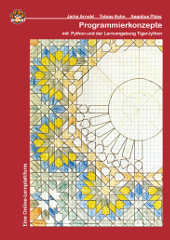Parallelschaltung Ohm'scher Widerstände (Schleifen)
Werden Ohm'sche (elektrische) Widerstände (R1, R2, R3, R4, ...) parallel geschaltet, wird der Gesamtwiderstand R durch die folgende Formel berechnet:
R = {1\over{{1\over{R_1}} + {1\over{R_2}} + {1\over{R_3}} + ...}}
oder
R = 1/Rinv; Rinv = 1/R1 + 1/R2 + 1/R3 + 1/R4 + ...
Zunächst soll die Anwenderin eingeben können, wie viele Widerstände insgesamt zu erfassen sind. Danach werden alle Widerstände sukzessive eingelesen und die Teilsumme Rinv := 1/R1, Rinv := Rinv + 1/R2, Rinv := Rinv + 1/R3, ... jedes Mal um den neuen Kehrwert ergänzt. Zum Schluss wird der Anwenderin R := 1/Rinv (der Gesamtwiderstand) ausgegeben.
Prüfen Sie Ihre Lösung mit den Zahlen im Verifikationsteil.
0 Kommentare
8 Lösung(en)
n = int(raw_input("Anzahl Widerstaende: "))
i = 1
rinv = 0.0
while (i <= n):
r = float(raw_input('Widerstand '+str(i)+' in Ohm :'))
rinv = rinv + 1/r
i = i + 1
print'Der Gesamtwiderstand ist R_tot= ' + str(1/rinv) + ' Ohm'
import java.util.Scanner;
public class ParallelWiderstand {
public static void main(String[] a) {
new ParallelWiderstand().top();
}
void top() {
int anzahl = eingabeAnzahl();
float[] widerstaende;
widerstaende = einlesenWiderstaende(anzahl);
float resultat = berechungParallelWiderstand(widerstaende);
ausgabeResultat(resultat);
}
void ausgabeResultat(float resultat) {
System.out.println("Der Parallelwiderstand ist " + resultat);
}
float berechungParallelWiderstand(float[] widerstaende) {
float result = 0;
for(float act : widerstaende) {
result = result + 1/act;
}
return 1/result;
}
float[] einlesenWiderstaende(int anzahl) {
float[] widerstaende = new float[anzahl];
for(int i = 1; i <= anzahl; i ++) {
widerstaende[i-1] = eingabeEinzelwiderstand(i);
}
return widerstaende;
}
Scanner sc = new Scanner(System.in);
float eingabeEinzelwiderstand(int i) {
System.out.println("R " + i + ": ");
return sc.nextFloat();
}
int eingabeAnzahl() {
System.out.println("Geben Sie die Anzahl Ri ein:");
return sc.nextInt();
}
} // end ParallelWiderstand
package ch.twidner;
import java.util.Scanner;
public class Parallelschaltung {
Scanner sc01 = new Scanner(System.in);
float gesamtwiderstand;
public static void main(String[] args) {
new Parallelschaltung().top();
}
void top() {
gesamtwiderstand = widerstaendeVerarbeiten("Anzahl Widerstände eingeben: ");
System.out.println("Gesamtwiderstand: " + (1 / gesamtwiderstand));
}
float widerstaendeVerarbeiten(String aufforderung) {
int anzahlWiderstaende;
float aktuellerWiderstand;
float gesamtWiderstand = 0;
System.out.println(aufforderung);
anzahlWiderstaende = sc01.nextInt();
for(int i = 1; i <= anzahlWiderstaende; i++) {
System.out.println("Widerstand " + (i) + ": ");
aktuellerWiderstand = sc01.nextFloat();
gesamtWiderstand = gesamtWiderstandBerechnen(aktuellerWiderstand, gesamtWiderstand);
}
return gesamtWiderstand;
}
float gesamtWiderstandBerechnen(float aktuellerWiderstand, float gesamtWiderstand) {
gesamtWiderstand += kehrwertBerechnen(aktuellerWiderstand);
return gesamtWiderstand;
}
float kehrwertBerechnen(float widerstand) {
return 1 / widerstand;
}
}
Lösung von: Tobias Widner (Santis AG)
{$R+}
{$B+}
program BerechneWiderstand (input,output);
{ Eingabe Anzahl von Wiederstanden und Einzelnen Werte von Wiederstaenden}
{FernUni Hagen}
type
tW = 1..maxint;
var
Ergebnis : real;
Eingabe,
Anzahl : tW;
StartWert : integer;
begin
StartWert :=1;
Eingabe :=1;
Ergebnis := 0;
Anzahl := 1;
write('Geben Sie die Anzahl von Wiederstaenden an: ');
readln(Anzahl);
for StartWert := 1 to Anzahl do
begin
write('Zahl nr ', StartWert,' eingeben: ');
read(Eingabe);
Ergebnis := Ergebnis + (1/Eingabe);
end;
Ergebnis := 1/Ergebnis;
write('Gesamtwiederstand: ', Ergebnis:2:4, ' Ohm');
read(); {Nur um die Konsole zu sehen}
end.
Lösung von: Name nicht veröffentlicht
function totalParallelResistance() {
let sum = 0;
for (let i = 0; i < arguments.length; i++) sum += 1 / arguments[i];
return 1 / sum;
}
// ausgabe
console.log( totalParallelResistance(20, 30, 40, 50) );
console.log( totalParallelResistance(30, 30, 470, 1000, 2000) );
Lösung von: Lisa Salander (Heidi-Klum-Gymnasium Bottrop)
// NET 6.x | C# 10.x | VS-2022
static double ParaRes(params double[] r) => 1 / r.Select(x => 1 / x).Sum();
Console.WriteLine(ParaRes(20, 30, 40, 50));
Console.WriteLine(ParaRes(30, 30, 470, 1000, 2000));
Lösung von: Jens Kelm (@JKooP)
// C++ 14 | VS-2022
#include <iostream>
#include <vector>
#include <numeric>
double get_parallel_resistance(const std::vector<double>& v) {
return 1.0 / std::accumulate(v.begin(), v.end(), 0.0, [](auto i, auto k) { return i + 1.0 / k; });
}
int main() {
std::cout << get_parallel_resistance({ 20, 30, 40, 50 }) << "\n";
std::cout << get_parallel_resistance({ 30, 30, 470, 1000, 2000 }) << "\n";
}
Lösung von: Jens Kelm (@JKooP)
// C++ 20
#include <iostream>
int main() {
constexpr auto get_parallel_resistance{ [] <typename ...T>(const T& ...param) { return 1 / ((1.0 / param) + ...); } };
std::cout << get_parallel_resistance(20, 30, 40, 50) << "\n";
std::cout << get_parallel_resistance(30, 30, 470, 1000, 2000) << "\n";
}
Lösung von: Jens Kelm (@JKooP)
Verifikation/Checksumme:
Parallelschaltung von
- 20, 30, 40 und 50 Ohm ergeben 7.7922... Ohm.
- 30, 30, 470, 1000, 2000 Ohm ergeben 14.2259... Ohm.
Suchmaschinen wie www.wolframalpha.com und www.bing.com erlauben direkt die Eingabe der Formel: 1/R = 1/20 + 1/30 + 1/40 + 1/50
Aktionen
Neue Lösung hinzufügen
Bewertung
Durchschnittliche Bewertung:
Meta
| Zeit: | 1 |
| Schwierigkeit: | k.A. |
| Webcode: | eisv-86s7 |
| Autor: | Philipp G. Freimann (BBW (Berufsbildungsschule Winterthur) https://www.bbw.ch) |




